July 9, 2014 feature
Liquid crystals controlled by magnetic fields may lead to new optical applications

(Â鶹ÒùÔº) —Liquid crystals are widely known for their use in LCD TVs, in which quickly changing electrical fields are used to control the molecular order of the liquid crystals. This in turn changes how light is transmitted through the liquid crystals to make the pictures change on the TV screen.
Liquid crystals can also be controlled, or actuated, by switching a magnetic field. Magnetic actuation has the advantage that it doesn't require direct contact, whereas electrical actuation requires contact with electrodes. However, so far all demonstrations of using magnetic fields to actuate liquid crystals have required extremely strong magnetic fields (~ 1 Tesla), limiting their practical use.
Now in a new study published in Nano Letters, researchers Mingsheng Wang, et al., at the University of California, Riverside; and Whittier College in Whittier, California, have demonstrated that weak magnetic fields (1 milliTesla) can effectively actuate liquid crystals. The magnetically actuated liquid crystals exhibit a switching speed of less than 0.01 seconds (frequency above 100 Hz), which is comparable to the performance of commercial liquid crystals based on electrical switching.
Key to the achievement was using magnetic iron oxide nanorods as building blocks to construct the liquid crystals. Due to their magnetic properties, the nanorods' orientations can be controlled by weak magnetic fields. Upon the application of an external magnetic field, the magnetic nanorods align themselves along the field direction.
This method provides a way to control the liquid crystals' optical properties because of the relationship between the nanorods' orientations and the amount of light that is transmitted through them. When the nanorods are oriented parallel (0°) or perpendicular (90°) to the polarizer, light intensity is very low so the display is dark. When the nanorods are oriented at 45° relative to the polarizer, light intensity is high so the display is bright. By rotating the magnetic field continuously, the researchers could cause continuous optical switching of the liquid crystal.
Another advantage of constructing liquid crystals out of inorganic nanostructures is that it opens up the possibility of permanently fixing the orientation of certain nanorods with lithography. To demonstrate, the researchers sandwiched a liquid crystal solution containing magnetic nanorods and resin between two pieces of glass. Then they placed a photomask on top, and used a UV light to cure the resin and fix the orientation of the nanorods in the uncovered regions of the photomask. Next, the researchers removed the photomask, rotated the magnetic field to change the orientation of the unfixed nanorods, and finally used the UV light again to fix these nanorods in the new orientation.
The result was a patterned liquid crystal whose dark and bright areas can be reversed by shifting the axis of the polarizer. Because the pattern is polarization-dependent, it could have applications in anti-counterfeiting devices.
"The liquid crystals can be made in a polymer thin film in which the orientation of magnetic nanorods can be fixed by combining magnetic alignment and lithography processes, thus creating patterns of different polarizations and control over the transmittance of light in particular areas," coauthor Yadong Yin, Professor at University of California-Riverside, told Â鶹ÒùÔº. "Such a thin film does not display visual information under normal light, but shows high contrast patterns under polarized light. The contrast of the patterns can also change with the direction of the polarized light, making them immediately very useful for anticounterfeiting or other information encryption applications."
With its advantageous features such as the electrode-less remote control of its optical properties and ability to fixate the liquid crystal orientation to create polarization patterns, the magnetically actuated liquid crystals could provide a new platform for fabricating other novel optical devices, including displays, waveguides, actuators, and optical modulators.
"Our magnetic liquid crystals show control of the transmittance of light so that they can have direct applications in displays such as signage, posters, writing tablets, and billboards, although their use as high-resolution displays (like computer monitors) might be limited due to the resolution in controlling the magnetic fields," Yin said. "They may also find applications as optical modulators, which are optical communication devices for controlling the amplitude, phase, polarization, and propagation direction of light."
In the future, the researchers plan to further improve the optical properties of the nanorods.
"The absorption of the iron oxide nanorods in the visible spectrum may limit some potential applications," Yin said. "Our next step will be reducing the optical absorption of the iron oxide nanorods, either by modifying the iron oxide nanorods to reduce their absorption or replacing them with other transparent magnetic nanorods. Our future efforts will also be made to explore the use of our materials for specific applications. Although we have envisioned many potential applications, it still requires significant efforts to optimize the technology to fit the specific needs of various applications."
More information: Mingsheng Wang, et al. "Magnetically Actuated Liquid Crystals." Nano Letters. DOI:
Journal information: Nano Letters
© 2014 Â鶹ÒùÔº




















